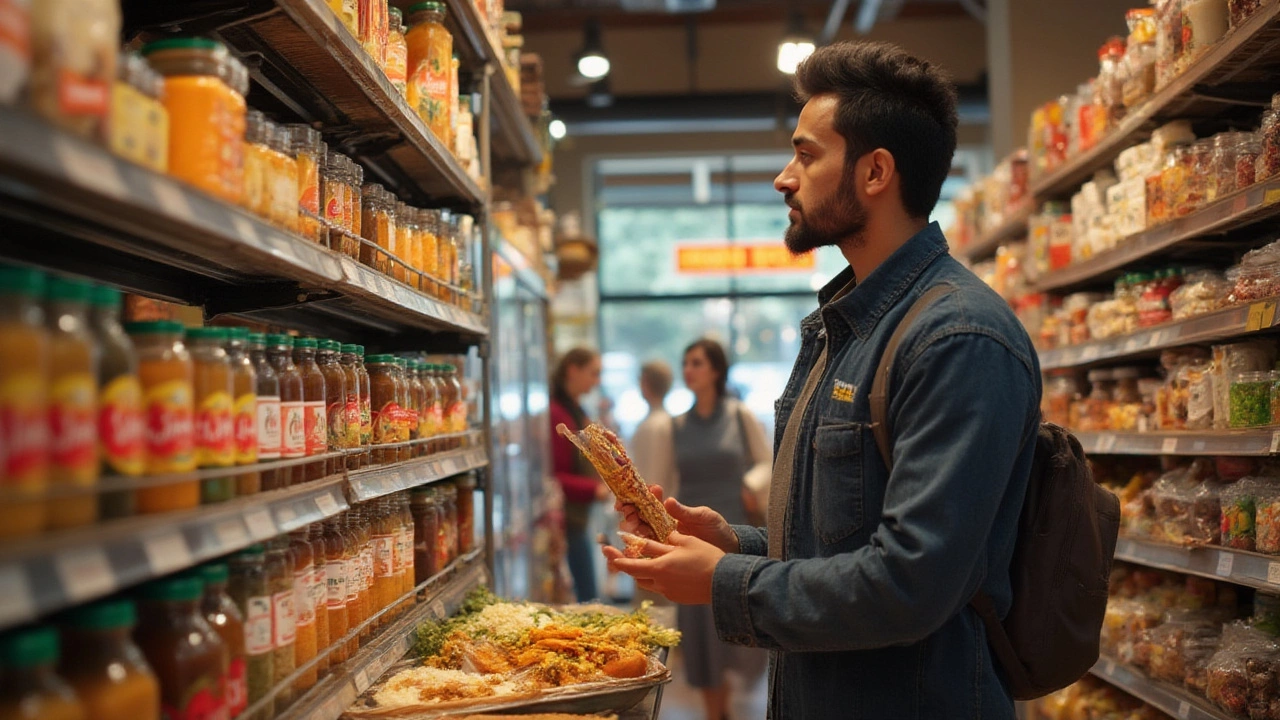The US food scene is like a hungry giant—craving everything from French cheese to Thai spices. Did you know the US imported over $160 billion worth of food in 2024, according to the USDA? There's serious money on the table for anyone willing to navigate customs, FDA regulations, and wild shipping delays. But the road isn't paved with croissants and kombucha. The trick is knowing exactly where to jump in and how to keep your product from getting stuck—or spoiled—at the border.
How the US Food Import Game Works: Navigating the Rules
Before you start dreaming about boatloads of Belgian chocolate, there’s red tape that’ll trip up the unprepared. The first thing the government cares about is public health. The Food and Drug Administration (FDA) watches over any food product entering US ports. One misstep—like a missing label or undeclared allergen—and your entire shipment could get detained or destroyed.
Here’s the first rule: every food importer needs to register their business with the FDA. This isn’t just a pointless form—if you skip it, US Customs and Border Protection (CBP) will block your shipments cold. Registration is free and can be done online. But that’s just the beginning.
Next up, all food facilities—anywhere making, packing, or storing the food—must be registered with the FDA. Even your grandma’s jam factory in Italy needs that number. It’s called the “Foreign Supplier Verification Program” (FSVP). You’re basically promising the FDA that your overseas producer follows US safety laws. If your partner can’t prove that, find a new one, or you risk fines that have run as high as $500,000.
The FDA also runs random border inspections. Last year, about 13% of all food shipments were physically examined, most flagged for poor documentation. Common reasons for rejection include missing ingredient lists, mislabeling (false health claims, undeclared allergens like peanuts), expired shelf life, or importing banned ingredients (the US really hates certain food colorings and raw milk products).
If you’re importing meat, poultry, or eggs, the USDA (not just the FDA) also needs to sign off. For seafood, don’t forget NOAA. This web of rules seems intimidating, but missing any piece of the puzzle can put you out of business halfway through your first container. It pays to read regulations directly from the FDA and USDA websites, but consider hiring a compliance consultant, especially for your first few imports. Their fees—often $2,000–$5,000—can save you six figures in legal trouble.
One last technical step: get a customs broker. These pros act as your middleman with CBP. Around 95% of food importers use brokers, according to the National Customs Brokers & Forwarders Association, since misfiled paperwork can result in costly demurrage fees—sometimes $100 or more a day when your container sits in port.
For quick reference, here's a snapshot of key agencies and their responsibilities:
| Agency | Role | What They Regulate |
|---|---|---|
| FDA | Safety & Labeling | Most food, ingredients, health standards, allergens |
| USDA | Agricultural Inspection | Meat, poultry, dairy, eggs, produce |
| CBP | Customs Clearance | All imported goods, tariffs, documentation |
| NOAA | Marine Products | Fish & seafood |
Dodge these agencies, and you’re likely to lose your entire investment—or worse, face a business-crippling recall.

Your First Import: Planning, Partners, and Paperwork
Let’s talk about what it really takes to get your first food shipment from, say, Vietnam to a supermarket shelf in Seattle.
First, pick your “niche.” Importing products with existing high US demand (like avocados, specialty cheeses, or exotic sauces) is safer, because retailers already buy these in big quantities. According to the US International Trade Commission, Mexican avocados alone made up $2.6 billion in imports last year. If you want quicker sales and less convincing for US buyers, don’t reinvent the wheel—start with proven staples.
Choosing a reliable overseas supplier is usually where new importers trip up. Use credit checks, business references (especially if you can talk to other US importers), and trial test shipments. Request lab reports or third-party certifications for safety and quality; for organic items, USDA certification is a must. Don’t just take their website’s word for it.
Next, map your shipping logistics. Most food imports arrive via ocean freight, since air is often too expensive except for super-premium perishables. Shipping containers need to be refrigerated (“reefer” containers) for anything perishable. Don’t ignore the calendar—plan arrival dates carefully to avoid spoilage, and factor in port congestion (Delays at the Port of Los Angeles soared in early 2024—sometimes up to two weeks, driven by labor shortages and global supply chain headaches.)
Now, the heart of the game: paperwork. Every shipment requires detailed documentation. At a minimum, you’ll need:
- Bill of Lading (proof of shipment, issued by the carrier)
- Commercial Invoice (lists product details and cost—used for customs and taxes)
- Packing List (describes what's in each package)
- Prior Notice (sent to the FDA before food arrives; skip this, and your cargo sits in customs limbo)
- Importer's declaration of compliance (proving you’re not sneaking in prohibited ingredients)
Keep copies of all contracts, insurance documents, and certificates for allergens, organic status, or other claims—most food buyers will ask for these. When you’re ready, have your customs broker file everything in the Automated Commercial Environment (ACE), the CBP’s online portal. This system flags errors instantly and can save you from expensive holdups.
Once your shipment clears customs, it’s just the start. You still have to arrange warehouse storage—preferably near your main customer base to cut delivery times. For perishable goods, contract with a USDA-inspected cold storage facility. Remember, temperature abuse is the top reason for spoilage claims.
Last, don’t forget insurance. Cargo insurance for international food shipments usually costs between 0.5% and 2% of the declared value. It’s worth every penny—one container of frozen shrimp is easily $100,000 in product. If your shipment gets lost, insurance keeps you from bleeding cash.

Getting Paid: Selling, Marketing, and Scaling Up
You’ve jumped all the regulatory hoops and your dream product is now sitting stateside. Now the real hustle begins: getting retailers or distributors to actually buy it.
First, do your homework. The Specialty Food Association’s 2024 report showed US consumers spent $194 billion on specialty foods, but the market is crowded. Unless you’re dramatically cheaper or have a unique, “Instagrammable” product story, you’ll need a creative pitch. Build a pitch deck with actual taste-test results, retail price comparisons, and buyer testimonials if possible. Top distributors like KeHE or UNFI want to see a real US demand before they risk valuable shelf space.
Samples matter. Plan to send out dozens—sometimes hundreds—of free samples to retail buyers, food critics, chefs, and even Instagram foodies. But before you do, check that your packaging meets US consumer packaging laws. That means nutrition facts panels (in English), proper allergen declarations, and serving size info. The FDA has handed out fines as high as $15,000 for bad labeling, so grab a template off their site or, better yet, have your graphics professionally designed.
Marketing is less about billboards, more about grassroots buzz. Pop into food festivals, run booths at local farmers’ markets (these are often cheap for new brands), and partner with small chains to test-run products. The fastest-growing brands in 2024? Kimchi, spicy snack mixes, and low-sugar beverages—all found traction with local events and food trucks before hitting big retailers. Use social proof: post real stories or customer reviews, since Americans are quick to buy food that feels authentic and “discovered.”
When you land your first buyer—whether it’s a local grocer or an online specialty shop—be ready with reliable delivery. US buyers care more about on-time shipments than almost anything else. Invest in a solid logistics network (many importers use third-party warehousing and 3PLs to spread risk and keep costs down). Automation can help; there are now apps like ShipBob or Stord that integrate directly with online sales channels to keep inventory in sync.
Scaling up takes guts. Once your product proves itself, look for ways to cut costs. Larger container loads drop your price per unit, but also increase risk. Never rely on a single supplier or shipping route—inflation, weather, or even wars can wipe out your profit if you’re not ready to pivot.
Networking counts. Join groups like the Food Export Association or your local chamber of commerce. They run trade missions, offer export grants, and connect you with in-the-know logistics and customs pros—sometimes saving you months of trial and error.
Finally, keep your records watertight. Tax audits for import businesses are no joke, and the IRS pays particular attention to international sourcing. There are niche CPAs who live and breathe import accounting—don't cheap out here. In 2023, dozens of small importers faced sudden six-figure fines simply for poor record-keeping or missing sales tax filings.
Bottom line? The US food import business has plenty of potholes but just as many rewards. It’s tough, but with the right groundwork, you’ll eat up the competition—literally. And hey, you may just build the next snack empire starting from your kitchen table.

